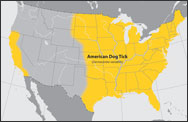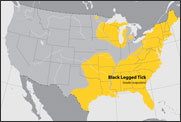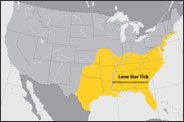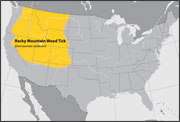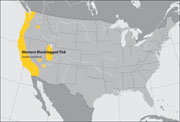Transmission
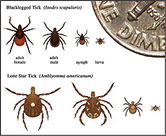
Life stages of ticks
For an image that depicts the relative size of these ticks, click here.
Tickborne rickettsial diseases in the United States are transmitted by Ixodidae (hard) ticks, specifically Ixodidae ticks (hard ticks).
These ticks have four stages in their life cycle: egg, larva, nymph, and adult. After the eggs hatch, each stage of tick must feed once to develop into the next stage. Ticks become infected while feeding on blood from an animal infected with the rickettsia. After the tick develops into the next stage, the infection may be transmitted to humans or other animals during the feeding process. Both male and female ticks may bite humans but it is the females that are responsible for most transmission.
Major Tick Vectors in the United States
American Dog Tick
American dog tick (Dermacentor variabilis) is the most commonly identified species responsible for transmitting R. rickettsii, which causes Rocky Mountain spotted fever in humans. This tick is widely distributed east of the Rocky Mountains and also occurs in limited areas on the Pacific Coast. Dogs and medium-sized mammals are the preferred hosts of adult D. variabilis, although it feeds readily on other large mammals, including humans.
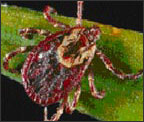
American dog tick
(Dermacentor variabilis)
Blacklegged Tick
The blacklegged tick (Ixodes scapularis) transmits Anaplasma phagocytophilum, causing anaplasomsis in humans. This tick is widely distributed in the northeastern and upper midwestern United States. Wild rodents and other mammals are likely reservoirs.
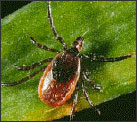
Blacklegged tick
(Ixodes scapularis)
Brown Dog Tick
The brown dog tick (Rhipicephalus sanguineus) has recently been identified as a possible reservoir of R. rickettsii, causing Rocky Mountain spotted fever in humans. This species is thoughth to play only a minor role in the ecology and transmission of R. rickettsii in the United States, but can cause infections in visitors to Central and South America. Brown dog ticks are found throughout the world. Dogs are the primary host for the brown dog tick for each of its life stages.
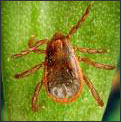
Brown Dog Tick
(Rhipicephalus sanguineus)
Lone Star Tick
The lone star tick (Amblyomma americanum) transmits Ehrlichia chaffeensis and Ehrlichia ewingii, causing human ehrlichiosis. The lone star tick is primarily found in the southeastern and eastern United States. White-tailed deer are a major host of lone star ticks and appear to represent one natural reservoir for E. chaffeensis.
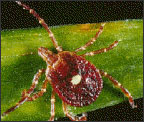
Lone star tick
(Amblyomma americanum)
Rocky Mountain Wood Tick
Rocky Mountain wood tick (Dermacentor andersoni) can transmit R. rickettsii, causing Rocky Mountain spotted fever, to humans. This tick is found in the Rocky Mountain states and in southwestern Canada. Adult ticks feed primarily on large mammals. Larvae and nymphs feed on small rodents.
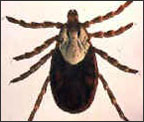
Rocky Mountain wood tick
(Dermacentor andersoni)
Western Blacklegged Tick
The western blacklegged tick (Ixodes pacificus) transmits Anaplasma phagocytophilum, causing anaplasomsis in humans. This tick is distributed along the Pacific coast of the United States. Wild rodents and other mammals are likely reservoirs.
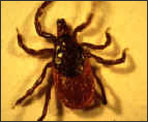
Western Blacklegged Tick
(Ixodes pacificus)
Other Tick Species
Other tick species like Amblyomma cajennense (Cayenne tick) has been shown to be naturally infected with R. rickettsii or serve as an experimental vector in the laboratory. While this species appears to play only a minor role in the ecology and transmission of R. rickettsii in the United States, it can cause infections in visitors to Central and South America.
Ixodes ricinus (the common tick) has been shown to be a vector of Anaplasma phagocytophilum in Europe.
- Page last reviewed: April 1, 2008
- Page last updated: August 19, 2008
- Content source: Division of Viral and Rickettsial Diseases, National Center for Zoonotic, Vector-Borne, and Enteric Diseases
Get email updates
To receive email updates about this page, enter your email address:
Contact Us:
- Centers for Disease Control and Prevention
Division of Viral and Rickettsial Diseases (DVRD)
1600 Clifton Rd
Atlanta, GA 30333 - 800-CDC-INFO
(800-232-4636)
TTY: (888) 232-6348
24 Hours/Every Day - cdcinfo@cdc.gov
